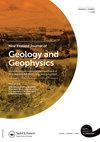Taupōinflate:说明陶普湖下岩浆膨胀的探测极限
IF 1.9
4区 地球科学
Q1 GEOLOGY
New Zealand Journal of Geology and Geophysics
Pub Date : 2022-05-18
DOI:10.1080/00288306.2022.2076700
引用次数: 6
摘要
本文章由计算机程序翻译,如有差异,请以英文原文为准。
Taupōinflate: illustrating detection limits of magmatic inflation below Lake Taupō
ABSTRACT Lake Taupō (Taupō-nui-a-Tia) infills the composite caldera above an active rhyolitic magmatic system in the central Taupō Volcanic Zone (TVZ). Ground deformation is a key unrest indicator at Taupō volcano. We present a spreadsheet tool, TaupōInflate, to calculate and plot ground deformation from magmatic inflation at depth beneath Taupō caldera. Examples show detection limits for inflating magma bodies and their ascent through the crust beneath Lake Taupō. Source locations where it is challenging to detect even substantial volumes of inflating magma bodies are as large as 20 km3, with volume changes up to 0.01 km3, owing to the restricted station placement around the lake, although a dike propagating from shallow crustal depths towards the surface is likely to be detectable. For a magma overpressure of 10 MPa, the sizes of detectable inflating bodies at depths of 5–8 km using the present monitoring system are larger than the volumes of many past eruptions, illustrating the importance of future improvements to the geodetic network. We discuss the potential for future equipment installation, including lakebed instrumentation that would require approval of local iwi Ngāti Tūwharetoa through the Tūwharetoa Māori Trust Board who oversee the health and wellbeing of Lake Taupō.
求助全文
通过发布文献求助,成功后即可免费获取论文全文。
去求助
来源期刊
CiteScore
5.10
自引率
27.30%
发文量
34
审稿时长
>12 weeks
期刊介绍:
Aims: New Zealand is well respected for its growing research activity in the geosciences, particularly in circum-Pacific earth science. The New Zealand Journal of Geology and Geophysics plays an important role in disseminating field-based, experimental, and theoretical research to geoscientists with interests both within and beyond the circum-Pacific. Scope of submissions: The New Zealand Journal of Geology and Geophysics publishes original research papers, review papers, short communications and letters. We welcome submissions on all aspects of the earth sciences relevant to New Zealand, the Pacific Rim, and Antarctica. The subject matter includes geology, geophysics, physical geography and pedology.

 求助内容:
求助内容: 应助结果提醒方式:
应助结果提醒方式:


